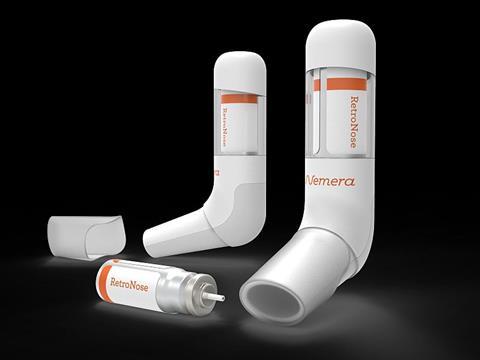
After announcing a partnership with the Research Center for Respiratory Diseases (CEPR) of Inserm/University of Tours in April 2017, Nemera is presenting enhanced drug deposition results compared to classic nasal sprays with RetroNose.
The number of applications through the nasal route is expanding, either for local treatments (e.g. chronic rhinosinusitis) or for systemic treatments such as migraine. The clinical efficacy of a nasal treatment depends on how it is deposited in the nose, because the pharmaceutical target (local, systemic, brain) is directly related to a specific nasal anatomical site. Therefore Nemera has collaborated with CEPR to develop a different and portable delivery technology called RetroNose for a better drug deposition in the distal region of the nose, without lung deposition.
RetroNose offers improved drug efficacy via a wide and homogeneous deposition, provide enhanced residence time, reduces patient to patient variability and offers the possibility of treatment of the nose and throat in one go with potential therapeutic benefits. As such, RetroNose technology improves the therapeutic effect of local and systemic nasal treatments.
How does it work?
RetroNose uses a breath-actuated pMDI to administer the drug through the buccal cavity during the nasal expiratory phase. The drug particles enter the nasal cavities through the rhinopharynx, which has a significant impact on drug deposition profile.
First outcomes of this partnership were presented at RDD 2018, to demonstrate the advantages of this technology resulting in an improved particle deposition in an upper airways model for local, vaccine and systemic drugs delivery. Then, during DDL 2018, it was shown that Retronose allows a more homogeneous and reproducible deposition in the different target regions of the nasal cavity compared to classic nasal spray in three different nasal cast models, This should have a positive impact on clinical outcomes for chronic rhinosinusitis patients.
Furthermore, a recent clinical study has presented data from five cases of asthmatic patients with rhinosinusitis treated with an aerosol therapy exhaled through the nose4 using a similar concept. This study proves that administering corticosteroid in the nasal cavity through the mouth is clinically efficient. This collaboration combines the specific know-how of CEPR and Nemera: CEPR’s know-how in respiratory pre-clinical and clinical research, as well as Nemera’s experience in development of drug delivery devices.
Nemera will present this concept at RDD conference in Lisbon which takes place from May 7th to May 10th, 2019 in Lisbon.




















